By Andrew Fazekas
How gene-enhanced stem cell therapy is changing medicine
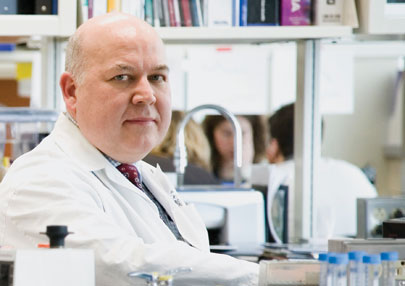
Self-repairing livers. A simple injection that regenerates osteoporosis-riddled bone. An end to diabetes, Parkinson’s and heart disease. Such notions smack of futuristic flights of fancy, but science fiction may soon become science fact, as a diverse group of McGill researchers discover how to use stem cells to restore, and even rebuild, the human body.
Leading the charge is Dr. Jacques Galipeau, a hematologist working at the Jewish General Hospital. He’s bringing together specialists from an eclectic group of disciplines, ranging from medicine to materials science, to lay the groundwork for the McGill Consortium for Stem Cell and Regenerative Medicine Research. “I am hoping to capture the unique talents and skills set found across McGill,” says Galipeau, “and be able to work as a multidisciplinary team developing cellular therapeutics.”
“Guardian Angels”
Stem cells are the blank slate of the human body, a tabula rasa waiting to be transformed into any specialized cell: bone, nerves, blood, organs. Scribble on the slate in just the right way and voila! you can (theoretically) direct the cells to become a new pancreas, or lung tissue, or nerves.
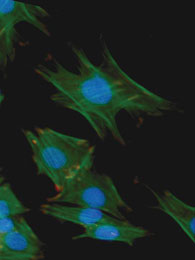
The controversy over the use of embryonic stem cells (ESC), derived from fetal tissue, has hit headlines across the world, especially in the United States, where federally funded ESC research is prohibited. There is, however, another type of stem cell that holds the potential for tissue regeneration: Adult stem cells are getting a lot of attention and support from the global scientific community, Galipeau says, because they are derived from the patient’s own body, thereby avoiding the ethical issues plaguing ESC research. Adult stem cells are not as flexible as ESCs; unlike their embryonic counterparts, they can only transform into a cell within their family. A marrow stromal cell, for example, can become bone or cartilage, but not blood. But choose the right family of cell and you’re set to unlock a chest of seemingly miraculous cures.
In early 2007, after nearly a decade of investigating cell therapy, Galipeau and his team at the Lady Davis Institute for Medical Research finally began their first clinical trial, only the nation’s second. The researchers used gene-enhanced adult stem cells to treat a patient suffering from pulmonary hypertension—a rare, often fatal disease affecting the lungs, for which a risky lung or combined heart and lung transplant is the only current cure.
Though adult stem cell therapies, like bone marrow transplants, have achieved only varying degrees of success in the past 40 years, these new clinical trials are opening new frontiers. This novel treatment involves growing stem cells, harvested from a patient’s blood, in a state-of-the-art, sterile laboratory (one of only two cell handling facilities in Canada). Researchers then infuse the stem cells with synthetic DNA (designed to reprogram the cells to produce nitric oxide, which helps repair damaged lung blood vessels), and then inject them intravenously back into the patient. Galipeau and his industrial partner, Northern Therapeutics Inc., hope that these enhanced cells will “act locally as guardian angels to protect the damaged lung tissue from death.”
“We are pushing the boundaries in regenerative medicine with these innovative technologies,” says Galipeau. “Using stem cells is probably the most exciting technology to come along that is offering us a novel way of treating catastrophic illnesses.”
Building a Community
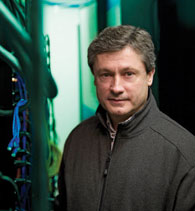
This unusual gene and stem cell therapeutic combination was developed in partnership with Dr. Duncan Stewart, Director of Cardiology at the University of Toronto—where, in November 2006, the world’s first human patient received treatment with this technology. Galipeau believes that advances in regenerative medicine depend on setting up both outside and in-house collaborations. Because stem cell research is “the new kid on the block” and involves expertise and technologies scattered across the country, finding potential partners can be tricky.
Galipeau credits Canada’s nationwide Stem Cell Network (SCN), one of 21 federal-government-funded Networks of Centres of Excellence, with building the partnerships that led to the current trials. Established in 2001, the SCN draws on the expertise of more than 70 leading scientists, physicians and engineers from universities and hospitals across the country. As leader of the SCN therapeutics group, Galipeau shepherds the teams trying to create treatments that target several now-incurable diseases (including stroke, Parkinson’s disease and blindness). “The strength behind the network lies in the fact that it is trying to move away from the paradigm of the solitary monk toiling away in his cell, towards a more multidisciplinary team approach to solving problems,” he says.
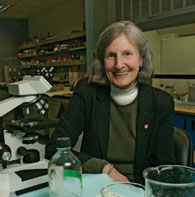
Now Galipeau hopes to create a local counterpart in the McGill Consortium. The MCSCR will not only perform basic investigative work, but will strive to bring the latest discoveries to patients as soon as possible. “We want to be forward thinking in putting in place a key enabling infrastructure to move as fast as we can to the clinic,” he adds.
Wiping the Slate Clean
After a quarter century of diabetes research, Dr. Lawrence Rosenberg, a professor in McGill’s Department of Surgery and Medicine and a collaborator in the nascent consortium, is finally seeing the light at the end of the tunnel. “Ultimately, I see a new treatment for diabetes emerging, and I think we’re close,” says Rosenberg. “There is momentum building and we’re getting some fascinating results.”
Rosenberg and his team at the McGill University Health Centre are developing a protein that can stimulate the body to rejuvenate its own pancreatic cells and produce insulin again. What makes this project unique is that, instead of actively seeking to identify and isolate the primitive undifferentiated stem cells, the approach assumes the pancreas retains the capacity to generate cells that make insulin—so the focus is on reviving that ability. The key, Rosenberg says, has been to set back the mature cells’ programming to their primitive progenitor state—to the blank slate, as it were. “It’s like taking you back to when you were only six months old.”
The drug has already successfully completed human safety trials, but the therapy won’t be ready for late- stage clinical trials for another couple of years. If this treatment does get off the ground within the next decade, it will have significant health and economic impacts. According to Rosenberg, 8 per cent of the Canadian population currently suffers from diabetes, with associated health care costs of $15 billion each year. “That’s for a disease that was supposed to have been cured by insulin,” he notes.
Mapping Osteoporosis
Janet Henderson, Associate Dean of Research in the Faculty of Medicine, is trying to unlock the mystery surrounding how stem cells can help fight age-related diseases in bones and joints. According to Osteoporosis Canada, treating the 1.4 million Canadians suffering from the disease costs the country nearly $2 billion in direct costs. Henderson warns of a looming health care crisis that could cost billions more as baby boomers reach the age of highest risk for osteoporosis. “The demographics show that we’re on a trajectory where we’re simply not going to be able to manage this disease in 10 to 20 years time,” she says.
With age, the spontaneous repair mechanisms begin to slow down, particularly in bones. “As you age, the capacity to renew declines and the population of the regenerative cells also declines,” Henderson explains. “The research that we’re doing, if we’re successful, is to get the stem cells that are already there in the bone marrow to be more active and help rebuild bone.”
Traditionally, doctors administer chemical growth factors (such as bone morphogenetic proteins) to help bone fractures heal faster in the elderly. However, Edward Harvey, one of Henderson’s collaborators, and Adam Hacking, a post-doctoral fellow, noticed that the actual surface texture of the broken bone had more of an effect on attracting stem cells and stimulating growth—but nobody had previously looked at why these cells seek out and repair the rough surfaces of broken bone. To understand what type of bone surface attracts these stem cells, Hacking is collaborating with Srikar Vengallatore, Canada Research Chair in Advanced Materials for Micro- and Nanosystems, to define the topography by examining how high and far apart the peaks or bumps are—in essence mapping out the landscape of the broken bone—then creating detailed replicas.
Bioconstruction Zone
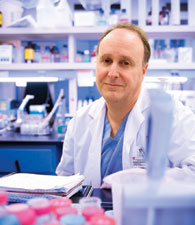
To manufacture these fake bones, Hacking, Harvey and Henderson are drawing on the expertise of Vengallatore and other researchers at McGill’s Institute for Advanced Materials (MIAM). Using nanotechnology equipment built for manufacturing semiconductors, MIAM’s materials scientists create dime-sized templates with different textured surfaces. They place stem cells on the fake bones, then determine which surfaces better promote the formation of tissue and bone. “Breaking down the barriers between disciplines and being able to work with different people makes this science so exciting,” says Henderson. “It’s amazing to think that we will be able very soon to fabricate bone-like surfaces using the same technology that makes computer chips.”
The microenvironment scale in which MIAM works is turning out to be the perfect match for stem cell research. Jorge Viñals, Professor of Physics and Director of MIAM, says that the scientists and engineers at the institute are keen on developing partnerships with other McGill departments. Projects on the MIAM drawing board range from building micro-sized cellular scaffolding on which stem cells can attach and multiply in order to help seal bone fractures, to engineering stem-cell-infused synthetic materials which can be surgically stitched into (or even entirely replace) damaged organs. “There is a growing awareness in both the scientific and medical communities that there is a clear overlap in what we do,” says Viñals, who notes that biologists are now focusing on the molecular scales that are the traditional playground of nanotechnologists.
Galipeau is keenly aware that time is of the essence in fulfilling the promise of stem cells. “There is a definite excitement in developing technology that’s never been done before. But this same passion is what drives me as a doctor—to try and help people with ailments for which there is currently no hope.”
For Linda Beliaut, who has suffered from the debilitating effects of pulmonary hypertension for 15 years, news of this clinical trial does give her hope. The once active elementary school teacher, who used to regularly bike and walk for miles, is now severely limited by her constant battle with fatigue and edema. She anxiously awaits the outcome of the McGill trials, excited about the prospects of having an alternative treatment. “I can’t imagine what it would be like to be healthy again,” she says. “Knowing that the only current way to eradicate my illness is through a transplant, this really would be a breakthrough.”
This research is funded by the Canadian Institutes of Health Research, the Canadian Diabetes Association, the Juvenile Diabetes Research Foundation, the Stem Cell Network and the Canadian Arthritis Network.
